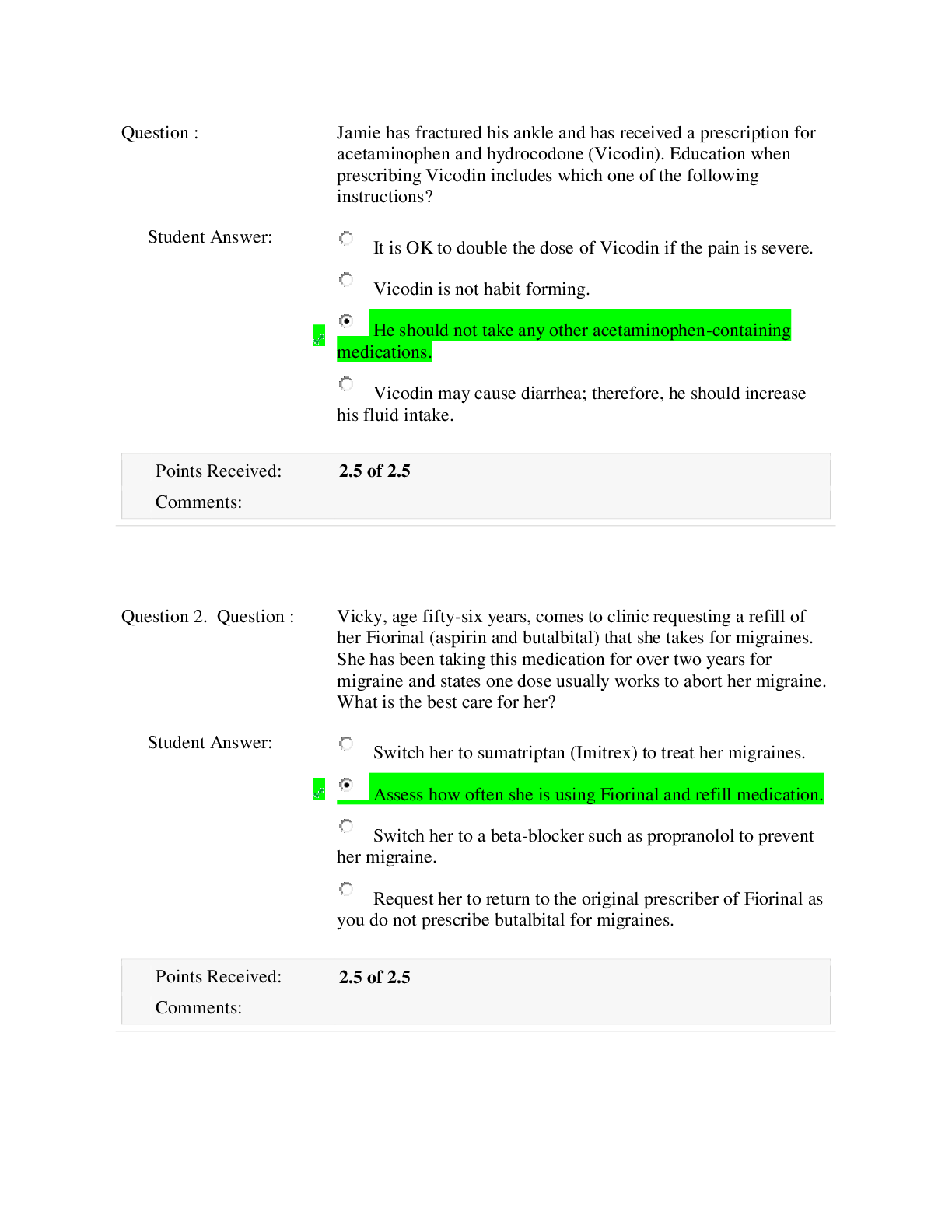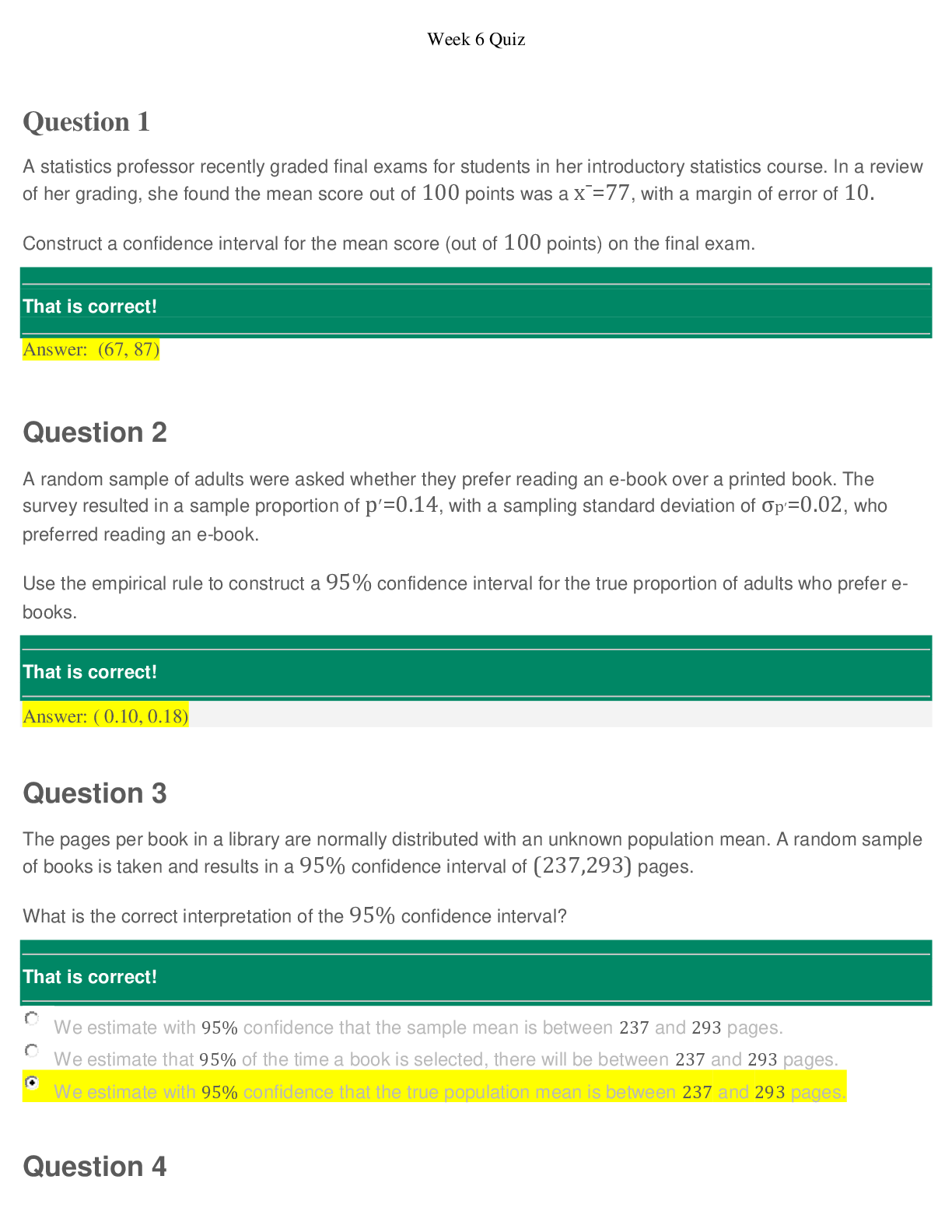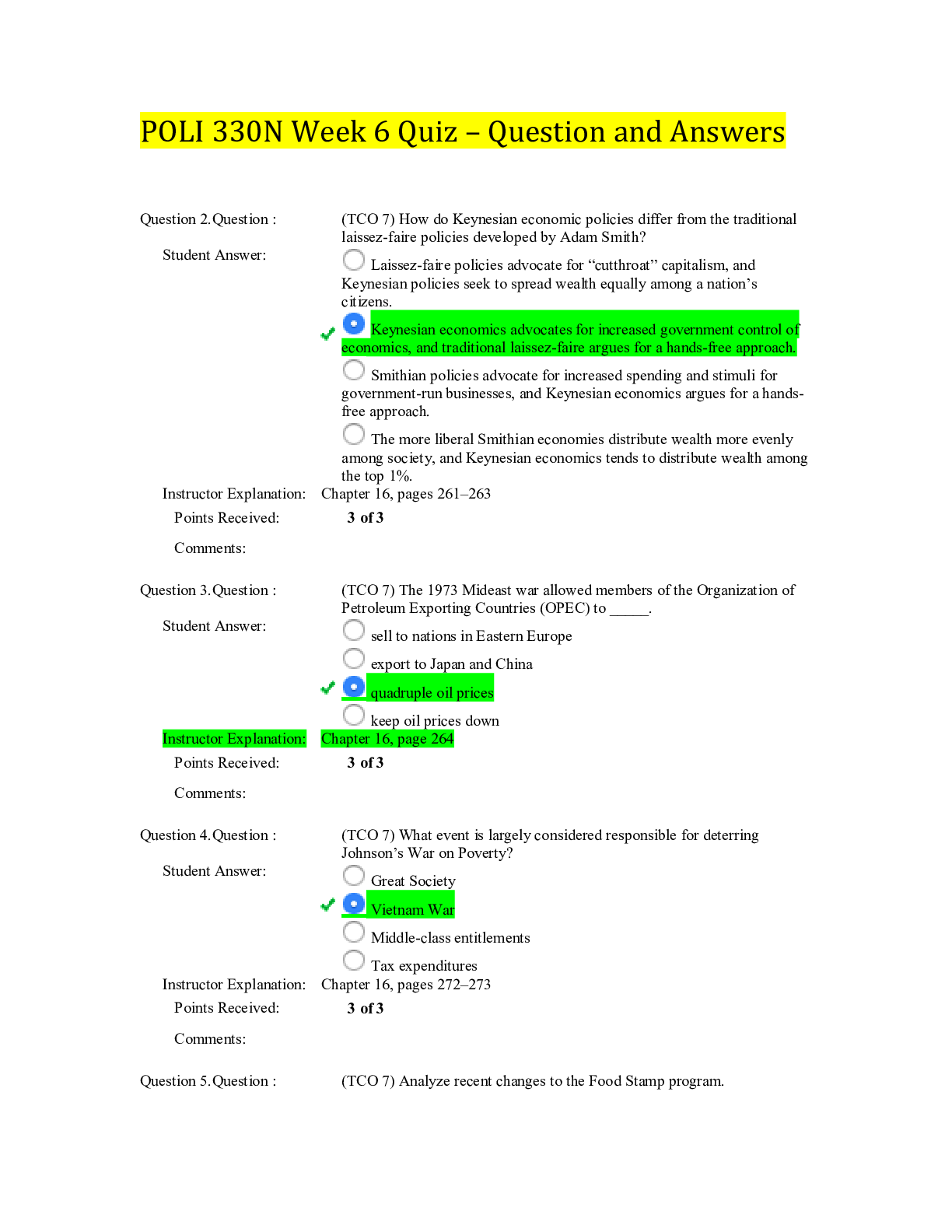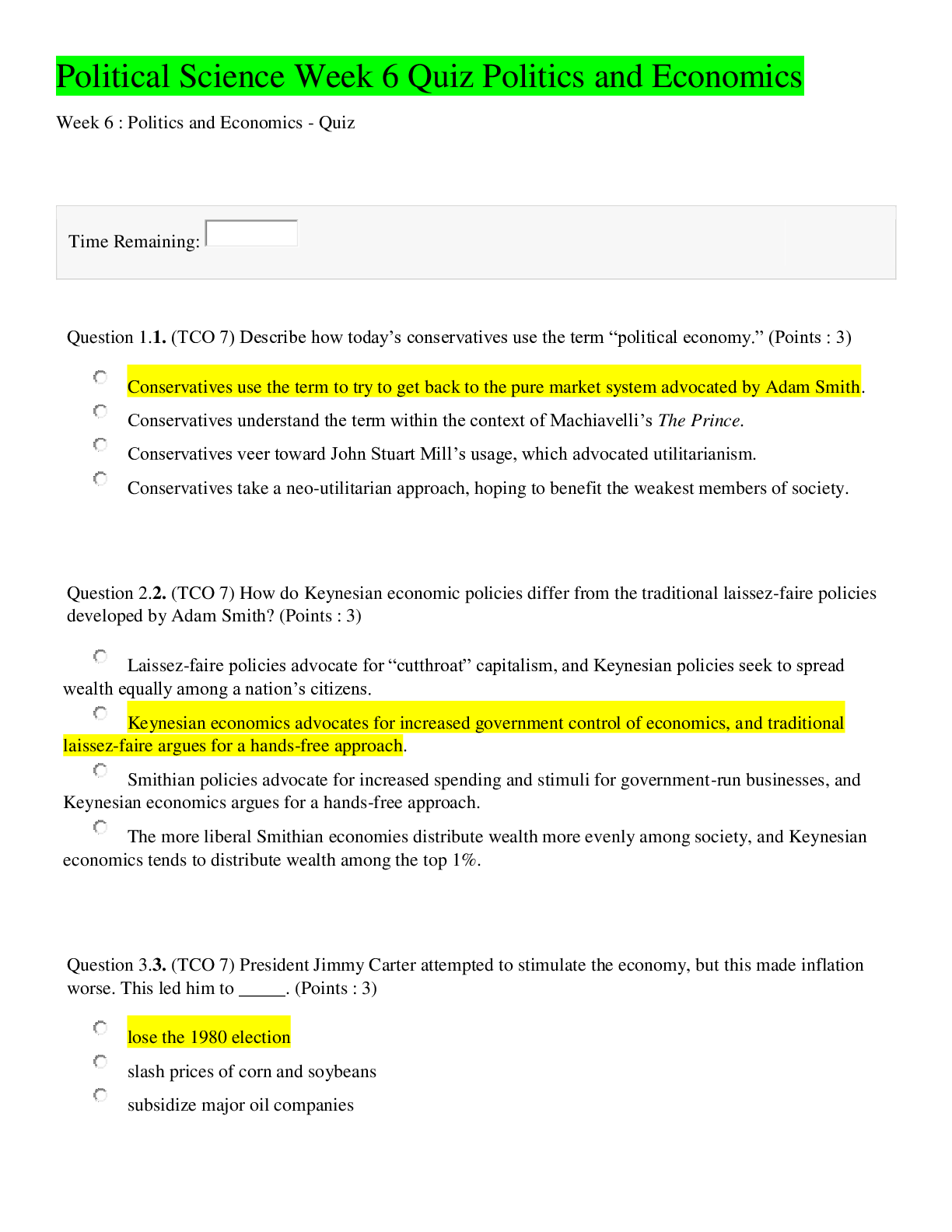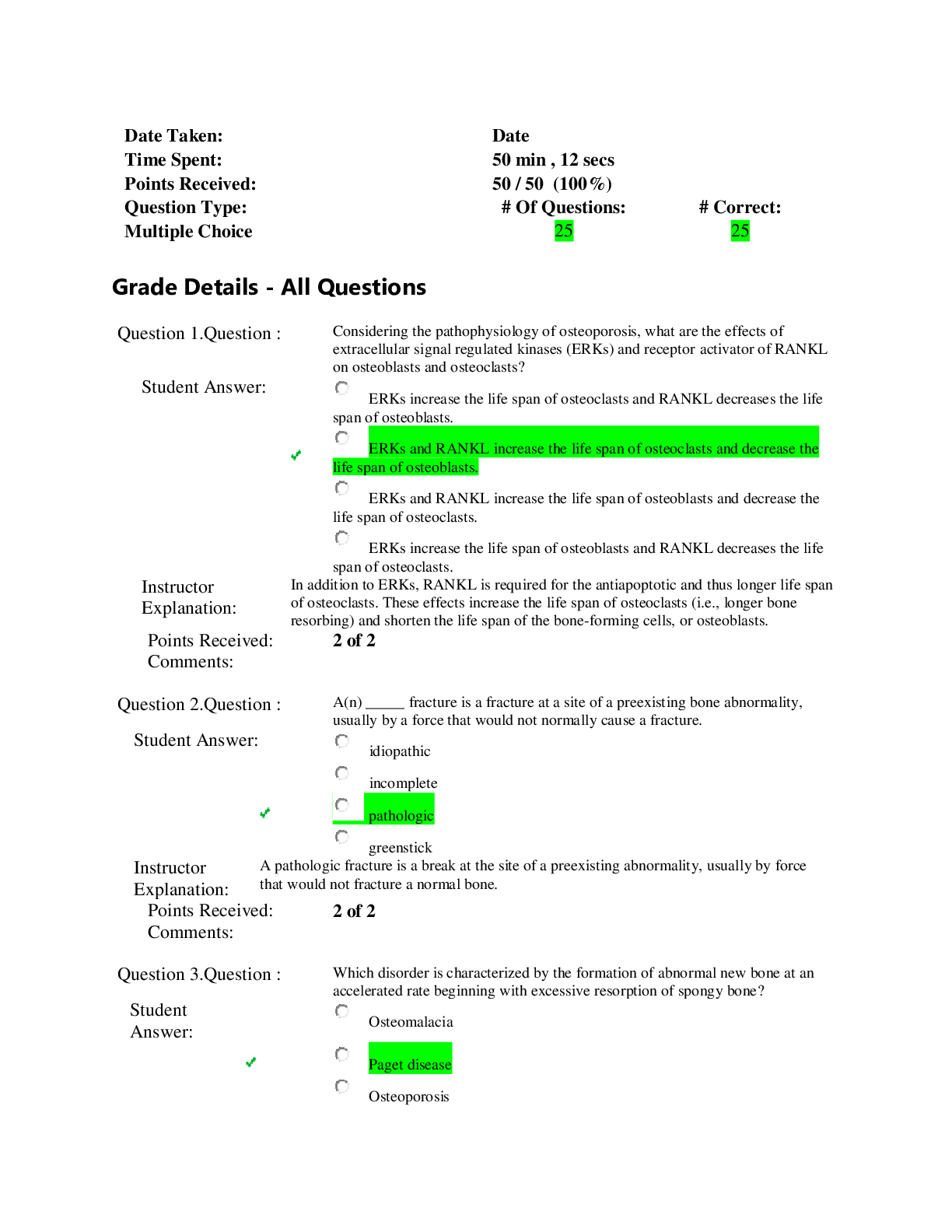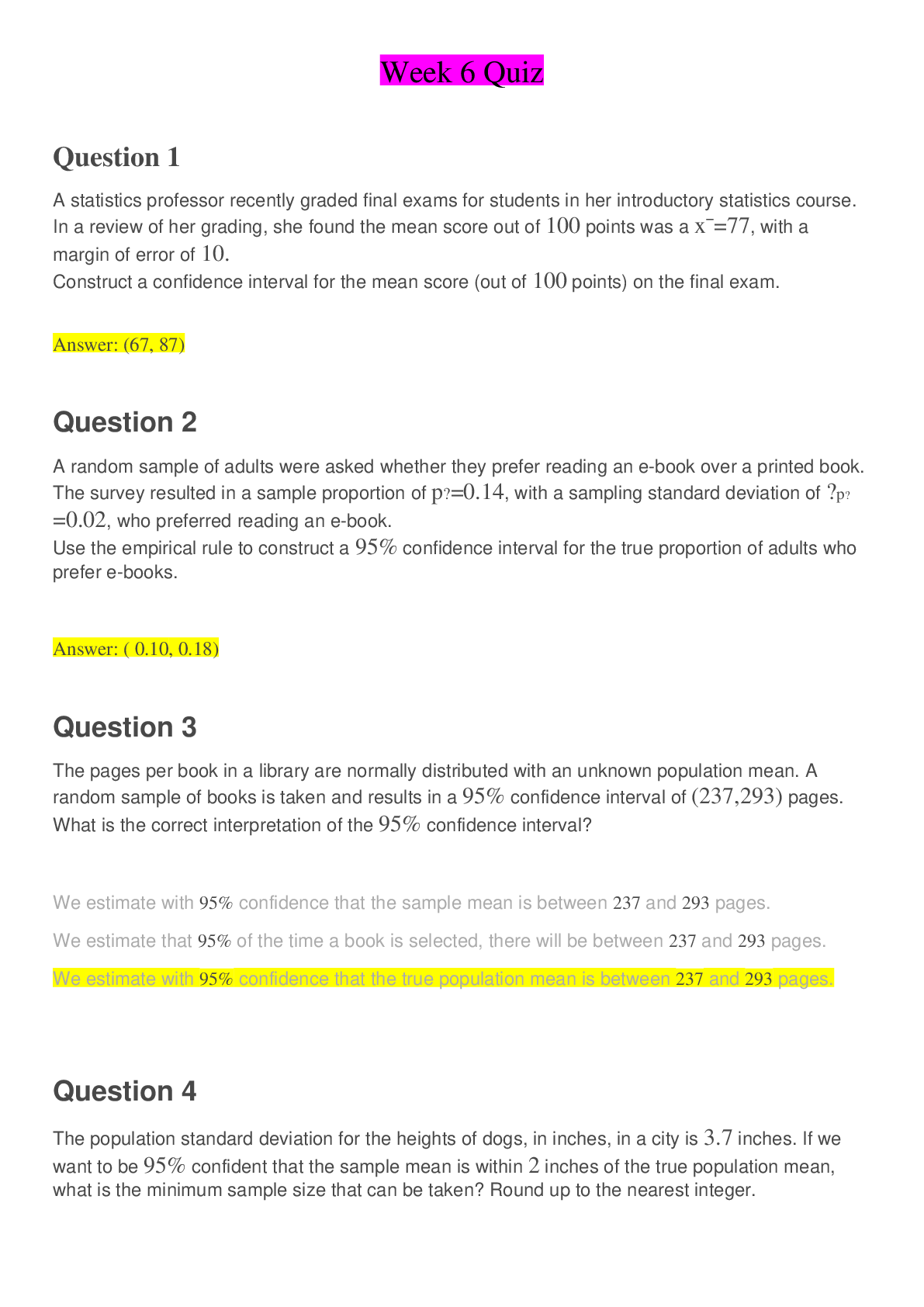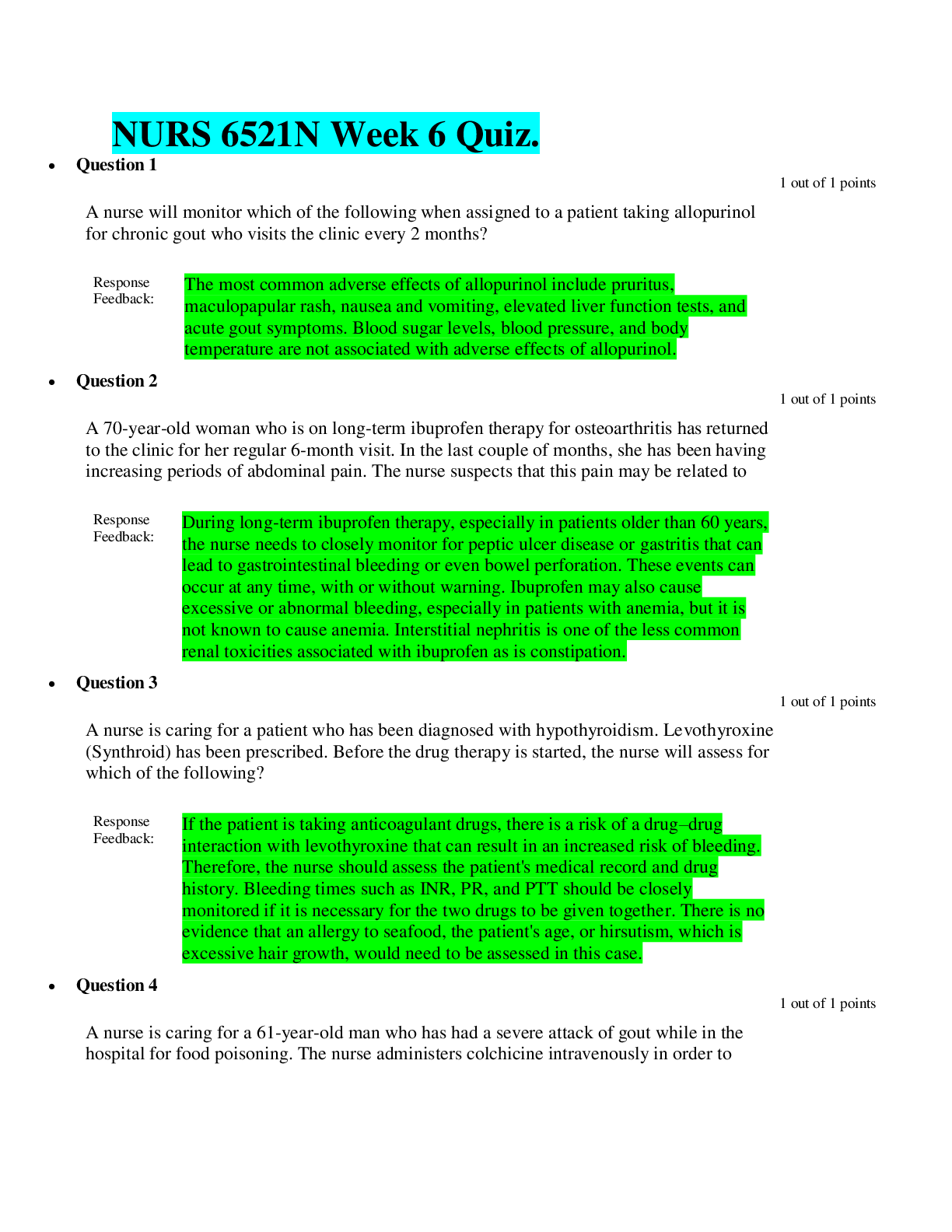*NURSING > EXAM > NURS 6512 Week 6 Quiz latest – Walden University | NURS6512 Week 6 Quiz latest (All)
NURS 6512 Week 6 Quiz latest – Walden University | NURS6512 Week 6 Quiz latest
Document Content and Description Below
NURS 6512 Week 6 Quiz latest – Walden University • Question 1 2 out of 2 points On a CXR, which of the following is true of the diaphragm? The right diaphragm is usuall... y higher. The right diaphragm is usually higher. • Question 2 2 out of 2 points Tactile fremitus is best felt: posteriorly and laterally at the bifurcation of the bronchi posteriorly and laterally at the bifurcation of the bronchi Response Feedback: Fremitus is best palpated at the second intercostal space, which also corresponds to the bifurcation of the bronchi. • Question 3 2 out of 2 points The middle lobe of the right lung is best auscultated over the: axilla. axilla. Response Feedback: The sounds of the middle lobe of the right lung are best heard in the right axilla. • Question 4 2 out of 2 points Expected respiratory changes of normal aging include: more prominent bony structures. more prominent bony structures. Response Feedback: In older adults, chest expansion is decreased and there is less use of respiratory muscles due to muscle weakness. The dorsal curve of the thoracic spine is prominent with flattening of the lumbar curve with bony landmarks becoming more prominent due to loss of subcutaneous tissue. • Question 5 2 out of 2 points You are listening to a patient s heart sounds in the aortic and pulmonic areas. The sound becomes asynchronous during inspiration. The prevalent heart sound to this area is most likely which of the following? S2 S2 Response Feedback: S2 marks the closure of the semilunar valves, which indicates the end of systole, and is best heard in the aortic and pulmonic areas. It is higher pitched and shorter than S1. S2 typically splits during inspiration. • Question 6 2 out of 2 points A bounding pulse in an infant may be associated with: patent ductus arteriosus. patent ductus arteriosus. Response Feedback: A bounding pulse is associated with a large left-to-right shunt produced by a patent ductus arteriosus. A weaker or thinner pulse represents diminished cardiac output or peripheral vasoconstriction. A difference in pulse amplitude between upper extremities, or between femoral and radial pulses, and absence of the femoral pulse suggests a coarctation of the aorta. Painful swollen extremities are usually a sign of venous occlusion. • Question 7 2 out of 2 points An apical PMI palpated beyond the left fifth intercostal space may indicate: left ventricular hypertrophy. left ventricular hypertrophy. Response Feedback: An apical impulse that is more forceful and widely distributed, fills systole, or is displaced laterally and downward may be indicative of left ventricular hypertrophy. Obesity, large breasts, and muscularity can obscure the visibility of the apical impulse. In dextrocardia the PMI would be displaced to the right. • Question 8 2 out of 2 points A palpable rushing vibration over the base of the heart at the second intercostal space is called a: thrill. thrill. Response Feedback: A thrill is a fine, palpable, rushing vibration; a palpable murmur. Cardiac thrills generally indicate a disruption of the expected blood flow related to some defect in the closure of one of the semilunar valves (generally aortic or pulmonic stenosis), pulmonary hypertension, or atrial septal defect. A heave or lift is a more vigorous apical impulse. A thrust is to move forward suddenly and forcibly. A murmur is an auscultated sound caused by turbulent blood flow. • Question 9 2 out of 2 points Bradypnea may accompany: an excellent level of cardiovascular fitness. an excellent level of cardiovascular fitness. Response Feedback: Bradypnea, a rate slower than 12 breaths per minute, may result from cardiorespiratory fitness. The other choices accompany tachypnea. • Question 10 0 out of 2 points Ms. R., age 74, has no known health problems or diseases. You are doing a preventive health care history and examination. Which symptom is associated with intrathoracic infection? Pectus carinatum Malodorous breath • Question 11 2 out of 2 points The apex of a 2-month-old baby s heart typically lies closest to the: fourth left intercostal space. fourth left intercostal space. Response Feedback: In infants and young children, the heart lies more horizontally in the chest. The apex of the heart is located higher, sometimes well out into the fourth left intercostal space. • Question 12 0 out of 2 points Closure of the ductus arteriosus usually occurs: 24 to 48 hours after birth. just prior to the initiation of labor. • Question 13 2 out of 2 points Nancy is a 16-year-old girl who presents to the clinic with complaints of severe, acute chest pain. Her mother reports that Nancy, apart from occasional colds, is not prone to respiratory problems. What potential risk factor is most important to assess concerning Nancy s present problem? Illegal drug use Illegal drug use Response Feedback: Illegal drug use, particularly cocaine, is especially important to prioritize as a social history question for all adolescents and adults who complain of severe chest pain. Cocaine can lead to tachycardia, hypertension, coronary arterial spasm with infarction, and pneumothorax. • Question 14 2 out of 2 points Laryngeal obstructions would elicit which breath sound? Stridor Stridor Response Feedback: Obstructions high in the respiratory tree are characterized by stridor. • Question 15 2 out of 2 points A patient you are seeing in the emergency department for chest pain is suspected of having a myocardial infarct. During the health history interview of his family history, he relates that his father had died of heart trouble. The most important follow-up question you should pose is which of the following? What age was your father at the time of his death? What age was your father at the time of his death? Response Feedback: A family history of sudden death, particularly in young and middle-aged relatives, significantly increases one s chance of a similar occurrence. • Question 16 2 out of 2 points In the fetus, the right ventricle pumps blood through the: ductus arteriosus. ductus arteriosus. Response Feedback: The right ventricle of a fetal heart pumps blood through the patent ductus arteriosus rather than into the lungs. • Question 17 2 out of 2 points A third heart sound is created by: diastolic filling. diastolic filling. Response Feedback: Diastole is a relatively passive interval until ventricular filling is almost complete. Diastole occurs when the ventricle is filling with blood from the atria and the filling sometimes produces a third heart sound S3. • Question 18 2 out of 2 points The level at which the jugular venous pulse is visible gives an indication of: right atrial pressure. right atrial pressure. Response Feedback: The level at which the jugular venous pulse is visible indicates right atrial pressure. The jugular veins empty into the superior vena cava, which empties into the right atria. The jugular venous system reflects the competency of the right side of the heart. The other four possible answers reflect the competency of the left side of the heart. • Question 19 2 out of 2 points What term would you use to document a respiratory rate greater than 20 per minute in an adult? Tachypnea Tachypnea Response Feedback: Tachypnea is the correct term for respirations greater than 20. Dyspnea, orthopnea, and platypnea are terms that describe respiratory effort, not rate. Cheyne-Stokes refers to a particular abnormal pattern of respiration. • Question 20 2 out of 2 points An expected finding from chest palpation in the adult would be: inflexibility of the xiphoid. inflexibility of the xiphoid. Response Feedback: The sternum and xiphoid in adults are relatively inflexible, without cracking; the expected normal costal angle is 90 degrees and the chest moves symmetrically. Crepitus is always an abnormal finding. [Show More]
Last updated: 2 years ago
Preview 1 out of 11 pages

Buy this document to get the full access instantly
Instant Download Access after purchase
Buy NowInstant download
We Accept:

Reviews( 0 )
$12.50
Can't find what you want? Try our AI powered Search
Document information
Connected school, study & course
About the document
Uploaded On
Nov 14, 2020
Number of pages
11
Written in
Additional information
This document has been written for:
Uploaded
Nov 14, 2020
Downloads
0
Views
74








 – University of the People.png)







